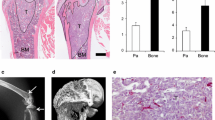Abstract
Melanoma is commonly associated with multi-organ metastasis, and bone is a frequent metastatic site for melanoma. However, the mechanism responsible for such melanoma-induced bone metastasis is still poorly understood. In the present study, the intracardiac inoculation of leukemia inhibitory factor (LIF)-producing human melanoma-derived cells (SEKI) developed osteolytic bone destruction in male BALB/cA-nu/nu nude mice. To elucidate the role of LIF in melanoma-induced osteolysis, cells were prepared in which the expression of LIF was reduced using a siRNA technique from the parent SEKI cells. Osteoclastogenesis was induced in the co-culture of LIF and/or SEKI cells with osteoblastic stromal cells in vitro, whereas the LIF-reduced SEKI cells did not induce osteoclastogenesis. The intracardiac inoculation of LIF-reduced SEKI cells resulted in a significant reduction in the incidence and number of bone metastasis in comparison to those in the mice inoculated with the parent SEKI cells. The expression of LIF was found in seven of nine human melanoma-derived cell lines, suggesting that LIF expression is a universal event in melanoma. These findings suggest that a potential role for LIF in the melanoma-induced bone metastasis possibly through the stimulation of osteoclastogenesis. LIF might therefore be a potentially effective drug target in the treatment of bone metastasis in melanoma.






Similar content being viewed by others
Abbreviations
- LIF:
-
Leukemia inhibitory factor
- PTHrP:
-
Parathyroid hormone-related protein
- GAPDH:
-
Glyceraldehydes-3-phosphate dehydrogenase
- siRNA:
-
Small interfering RNA
- TRAP:
-
Tartrate-resistant acid phosphatase
- DAB:
-
3,3′-Diaminobenzidine tetrahydrochloride
- HPCs:
-
Hematopoietic cells
- OCLs:
-
Osteoclasts
- BV:
-
Bone volume
- TV:
-
Tissue volume
- ES:
-
Eroded bone surface
- BS:
-
Bone surface
References
Roodman GD (2004) Mechanisms of bone metastasis. N Engl J Med 350:1655–1664. doi:10.1056/NEJMra030831
Iguchi H, Tanaka S, Ozawa Y et al (1996) An experimental model of bone metastasis by human lung cancer cells: the role of parathyroid hormone-related protein in bone metastasis. Cancer Res 56:4040–4043
Croucher PI, Shipman CM, Lippitt J et al (2001) Osteoprotegerin inhibits the development of osteolytic bone disease in multiple myeloma. Blood 98:3534–3540. doi:10.1182/blood.V98.13.3534
Abe M, Hiura K, Wilde J et al (2002) Role for macrophage inflammatory protein (MIP)-1alpha and MIP-1beta in the development of osteolytic lesions in multiple myeloma. Blood 100:2195–2202
Guise TA, Yin JJ, Taylor SD et al (1996) Evidence for a causal role of parathyroid hormone-related protein in the pathogenesis of human breast cancer-mediated osteolysis. J Clin Invest 98:1544–1549. doi:10.1172/JCI118947
Onuma E, Sato K, Saito H et al (2004) Generation of a humanized monoclonal antibody against human parathyroid hormone-related protein and its efficacy against humoral hypercalcemia of malignancy. Anticancer Res 24:2665–2673
Shimoyama M (1975) SEKI strain. In: Oboshi S, Sugano H (eds) In vitro culture of human cancer cells. Asakura Shoten, Tokyo, pp 208–215
Kondo Y, Sato K, Ueyama Y et al (1981) Serum sialyltransferase and liver catalase activity in cachectic nude mice bearing a human malignant melanoma. Cancer Res 41:2912–2916
Mori M, Yamaguchi K, Honda S et al (1991) Cancer cachexia syndrome developed in nude mice bearing melanoma cells producing leukemia-inhibitory factor. Cancer Res 51:6656–6659
Gearing DP, Gough NM, King JA et al (1987) Molecular cloning and expression of cDNA encoding a murine myeloid leukaemia inhibitory factor (LIF). EMBO J 6:3995–4002
Kurzrock R, Estrov Z, Wetzler M et al (1991) LIF: not just a leukemia inhibitory factor. Endocr Rev 12:208–217
Alexander HR, Billingsley KG, Block MI et al (1994) D-factor/leukaemia inhibitory factor: evidence for its role as a mediator in acute and chronic inflammatory disease. Cytokine 6:589–596. doi:10.1016/1043-4666(94)90045-0
Palmqvist P, Persson E, Conaway HH et al (2002) IL-6, leukemia inhibitory factor, and oncostatin M stimulate bone resorption and regulate the expression of receptor activator of NF-kappa B ligand, osteoprotegerin, and receptor activator of NF-kappa B in mouse calvariae. J Immunol 169:3353–3362
Takahashi N, Akatsu T, Udagawa N et al (1988) Osteoblastic cells are involved in osteoclast formation. Endocrinology 123:2600–2602
van de Wijngaert FP, Burger EH (1986) Demonstration of tartrate-resistant acid phosphatase in un-decalcified, glycolmethacrylate-embedded mouse bone: a possible marker for (pre)osteoclast identification. J Histochem Cytochem 34:1317–1323
Arguello F, Furlanetto RW, Baggs RB et al (1992) Incidence and distribution of experimental metastases in mutant mice with defective organ microenvironments (genotypes Sl/Sld and W/Wv). Cancer Res 52:2304–2309
Oda Y, Takahira T, Kawaguchi K et al (2003) Altered expression of cell cycle regulators in myxofibrosarcoma, with special emphasis on their prognostic implications. Hum Pathol 34:1035–1042. doi:10.1053/S0046-8177(03)00404-0
Bendre MS, Gaddy-Kurten D, Mon-Foote T et al (2002) Expression of interleukin 8 and not parathyroid hormone-related protein by human breast cancer cells correlates with bone metastasis in vivo. Cancer Res 62:5571–5579
Bendre MS, Margulies AG, Walser B et al (2005) Tumor-derived interleukin-8 stimulates osteolysis independent of the receptor activator of nuclear factor-kappaB ligand pathway. Cancer Res 65:11001–11009. doi:10.1158/0008-5472.CAN-05-2630
Ono K, Akatsu T, Murakami T et al (2002) Involvement of cyclo-oxygenase-2 in osteoclast formation and bone destruction in bone metastasis of mammary carcinoma cell lines. J Bone Miner Res 17:774–781. doi:10.1359/jbmr.2002.17.5.774
Mattei S, Colombo MP, Melani C et al (1994) Expression of cytokine/growth factors and their receptors in human melanoma and melanocytes. Int J Cancer 56:853–857. doi:10.1002/ijc.2910560617
Sanchez-Sweatman OH, Lee J, Orr FW et al (1997) Direct osteolysis induced by metastatic murine melanoma cells: role of matrix metalloproteinases. Eur J Cancer 33:918–925. doi:10.1016/S0959-8049(97)00513-3
Wysoczynski M, Miekus K, Jankowski K et al (2007) Leukemia inhibitory factor: a newly identified metastatic factor in rhabdomyosarcomas. Cancer Res 67:2131–2140. doi:10.1158/0008-5472.CAN-06-1021
Author information
Authors and Affiliations
Corresponding author
Rights and permissions
About this article
Cite this article
Maruta, S., Takiguchi, S., Ueyama, M. et al. A role for leukemia inhibitory factor in melanoma-induced bone metastasis. Clin Exp Metastasis 26, 133–141 (2009). https://doi.org/10.1007/s10585-008-9223-x
Received:
Accepted:
Published:
Issue Date:
DOI: https://doi.org/10.1007/s10585-008-9223-x




